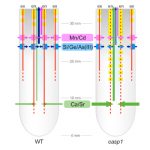Plant Science Research Weekly: September 27th
Evolutionary flexibility in flooding response circuitry in angiosperms ($)
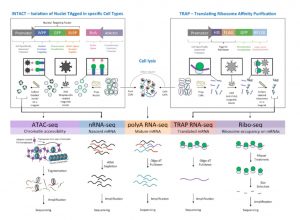 Flooding is unpredictable and can lead to plant death due to insufficient oxygen (hypoxia). Some plant species and varieties are better able to survive periods of submergence. Here, Reynoso et al. looked at gene networks induced transcriptionally and translationally by flooding in rice, Medicago and two Solanum species. They identified several gene families with at least one submergence up-regulated member (submergence up-regulated families; SURFs) conserved across the four species. The authors also identified four enriched transcription factor binding sites across the hypoxia-induced genes. Syntenic genes (positionally conserved across species) showed more coordinated expression than non-syntenic genes. Although the four species show some differences in their flooding responses, this work also identified four highly conserved submergence activated modules and seven SURF loci that can be valuable breeding targets. (Summary by Mary Williams) Science 10.1126/science.aax8862
Flooding is unpredictable and can lead to plant death due to insufficient oxygen (hypoxia). Some plant species and varieties are better able to survive periods of submergence. Here, Reynoso et al. looked at gene networks induced transcriptionally and translationally by flooding in rice, Medicago and two Solanum species. They identified several gene families with at least one submergence up-regulated member (submergence up-regulated families; SURFs) conserved across the four species. The authors also identified four enriched transcription factor binding sites across the hypoxia-induced genes. Syntenic genes (positionally conserved across species) showed more coordinated expression than non-syntenic genes. Although the four species show some differences in their flooding responses, this work also identified four highly conserved submergence activated modules and seven SURF loci that can be valuable breeding targets. (Summary by Mary Williams) Science 10.1126/science.aax8862
A virtual nodule environment (ViNE) of metabolic integration during symbiotic nitrogen fixation
 Genetic and molecular studies have revealed a complex exchange of signals and metabolites accompanying the development and process of symbiotic nitrogen fixation. Clearly, the photosynthesis-capable plant provides fixed carbon to the bacterial symbiont, which uses some of this energy for its core metabolism and some to drive energetically-expensive nitrogen fixation by nitrogenase. For a greater understanding of these processes, DiCenzo et al. have developed a model in which to simulate flux-balance analysis. They considered plant shoot, root, and nodule tissues, with the nodule represented as a series of differentiation zones with different metabolic activities, and incorporated data about enzyme activities and metabolites, as well as the consequences of altering them. Their findings suggest that the majority of fixed carbon provided to the bacteria is used directly to support nitrogenase activity, and also that there are diminishing returns in terms of plant growth with increases in nitrogenase activity. The authors observe their findings may be good news for efforts to engineer N-fixation into cereals, as “even a low efficiency symbiosis has the potential to have a noticeable benefit on crop yield.” (Summary by Mary Williams) bioRxiv 10.1101/765271v1
Genetic and molecular studies have revealed a complex exchange of signals and metabolites accompanying the development and process of symbiotic nitrogen fixation. Clearly, the photosynthesis-capable plant provides fixed carbon to the bacterial symbiont, which uses some of this energy for its core metabolism and some to drive energetically-expensive nitrogen fixation by nitrogenase. For a greater understanding of these processes, DiCenzo et al. have developed a model in which to simulate flux-balance analysis. They considered plant shoot, root, and nodule tissues, with the nodule represented as a series of differentiation zones with different metabolic activities, and incorporated data about enzyme activities and metabolites, as well as the consequences of altering them. Their findings suggest that the majority of fixed carbon provided to the bacteria is used directly to support nitrogenase activity, and also that there are diminishing returns in terms of plant growth with increases in nitrogenase activity. The authors observe their findings may be good news for efforts to engineer N-fixation into cereals, as “even a low efficiency symbiosis has the potential to have a noticeable benefit on crop yield.” (Summary by Mary Williams) bioRxiv 10.1101/765271v1
Deep conservation of cis-element variants regulating plant hormonal responses
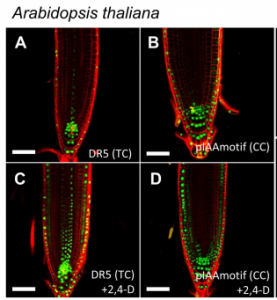 Promoter regions upstream of transcription start sites contain DNA regulatory elements (RE) crucial for the transcriptional control of gene expression. However, REs are short degenerated sequences with low conservation during evolution. In this paper, Lieverman-Lazarovich et al. studied REs in core hormone response genes. The authors develop an alignment-free computational approach to find cases where degenerated parts of the RE are conserved across the evolution of angiosperms. They found cases of “deep” sequence conservation for different hormone responses RE, including auxin, cytokinins, and abscisic acid. These conserved elements could be physiologically important for the precise regulation of gene expression. The authors shows experimentally in Arabidopsis how conserved variants present optimal expression responses as in vivo fluorescent reporters for hormonal responses. Moreover, single nucleotide changes in promoter regions of responsive genes affect expression under hormonal treatments. These findings are important to improve our understanding of the evolution of promoter regions but also to advance the rational design of promoters for synthetic biology in plants. Based on their findings, the authors also present a novel auxin reporter system that works in both Arabidopsis and tomato. (Summary by Facundo Romani) Plant Cell 10.1105/tpc.19.00129
Promoter regions upstream of transcription start sites contain DNA regulatory elements (RE) crucial for the transcriptional control of gene expression. However, REs are short degenerated sequences with low conservation during evolution. In this paper, Lieverman-Lazarovich et al. studied REs in core hormone response genes. The authors develop an alignment-free computational approach to find cases where degenerated parts of the RE are conserved across the evolution of angiosperms. They found cases of “deep” sequence conservation for different hormone responses RE, including auxin, cytokinins, and abscisic acid. These conserved elements could be physiologically important for the precise regulation of gene expression. The authors shows experimentally in Arabidopsis how conserved variants present optimal expression responses as in vivo fluorescent reporters for hormonal responses. Moreover, single nucleotide changes in promoter regions of responsive genes affect expression under hormonal treatments. These findings are important to improve our understanding of the evolution of promoter regions but also to advance the rational design of promoters for synthetic biology in plants. Based on their findings, the authors also present a novel auxin reporter system that works in both Arabidopsis and tomato. (Summary by Facundo Romani) Plant Cell 10.1105/tpc.19.00129
Control of adventitious rooting by TIR1/AFB2-Aux/IAA-dependent auxin signaling ($)
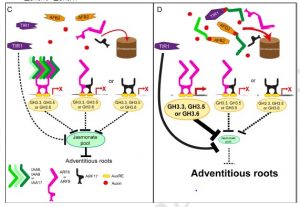 Adventitious roots typically develop from non-root tissue like shoots either naturally in some species or upon induction by stress in most species. The key roles of auxin signaling in lateral root development are well known but the role of these regulators in adventitious roots with their high phenotypic plasticity is still unknown. In this paper, Lakehal et al. have identified that during adventitious root formation, TIR1and AFB2 (TRANSPORT INHIBITOR1/AUXIN_SIGNALLING F_BOX2) of the auxin signaling pathway interact with each other and activate ARF6 and/or ARF8 (AUXIN RESPONSE FACTOR) to regulate the expression of specific GH3 (GRETCHEN HAGEN 3) genes, which in addition to inactivating IAA also inactivate jasmonic acid (JA), an inhibitor of AR initiation in Arabidopsis hypocotyls. Through genetic knockdown, the authors showed that IAA6, IAA9, and IAA17 also participate in auxin signaling, and the loss-of-function alleles of these regulators cause a significant increase in adventitious root formation and change the expression of GH3.3, GH3.5, and GH3.6. The authors propose a molecular framework involving auxin – jasmonic acid regulation of adventitious root development in Arabidopsis. (Summary by Suresh Damodaran) Mol. Plant 10.1016/j.molp.2019.09.001
Adventitious roots typically develop from non-root tissue like shoots either naturally in some species or upon induction by stress in most species. The key roles of auxin signaling in lateral root development are well known but the role of these regulators in adventitious roots with their high phenotypic plasticity is still unknown. In this paper, Lakehal et al. have identified that during adventitious root formation, TIR1and AFB2 (TRANSPORT INHIBITOR1/AUXIN_SIGNALLING F_BOX2) of the auxin signaling pathway interact with each other and activate ARF6 and/or ARF8 (AUXIN RESPONSE FACTOR) to regulate the expression of specific GH3 (GRETCHEN HAGEN 3) genes, which in addition to inactivating IAA also inactivate jasmonic acid (JA), an inhibitor of AR initiation in Arabidopsis hypocotyls. Through genetic knockdown, the authors showed that IAA6, IAA9, and IAA17 also participate in auxin signaling, and the loss-of-function alleles of these regulators cause a significant increase in adventitious root formation and change the expression of GH3.3, GH3.5, and GH3.6. The authors propose a molecular framework involving auxin – jasmonic acid regulation of adventitious root development in Arabidopsis. (Summary by Suresh Damodaran) Mol. Plant 10.1016/j.molp.2019.09.001
A novel hypothesis for the role of photosynthetic physiology in shaping macroevolutionary patterns
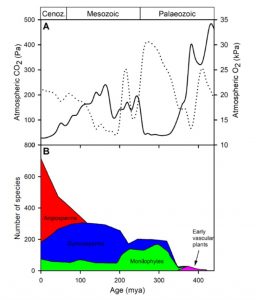 In the 450 million(ish) years since plants acquired the ability to live on land, they have caused dramatic changes in the concentrations of atmospheric CO2 and O2 levels. As an example, due to tremendous increases in photosynthesis, CO2 levels dropped and O2 levels rose dramatically in the late Paleozoic (about 300 million years ago), but then these trends were reversed due to increased plate tectonic and volcano activity. These striking atmospheric changes coincide with changes in the dominance of three groups of vascular plants: first the ferns, then gymnosperms during the period of highest CO2 levels, followed by angiosperms in the time when CO2 levels declined again. In this Letter, Yiotis and McElwain investigate how these atmospheric changes might have affected the fitness of these three groups of plants, through modelling following measurements made while altering both gas levels. They show that the groups differ in their photosynthetic efficiency (as consequences of mesophyll and stomatal conductance, as well as Rubisco efficiency) at various CO2 and O2 levels, which may have contributed to their relative abundance. They also note that rising CO2 levels today are likely to favor gymnosperms. (Summary by Mary Williams) Plant Physiol. 10.1104/pp.19.00749
In the 450 million(ish) years since plants acquired the ability to live on land, they have caused dramatic changes in the concentrations of atmospheric CO2 and O2 levels. As an example, due to tremendous increases in photosynthesis, CO2 levels dropped and O2 levels rose dramatically in the late Paleozoic (about 300 million years ago), but then these trends were reversed due to increased plate tectonic and volcano activity. These striking atmospheric changes coincide with changes in the dominance of three groups of vascular plants: first the ferns, then gymnosperms during the period of highest CO2 levels, followed by angiosperms in the time when CO2 levels declined again. In this Letter, Yiotis and McElwain investigate how these atmospheric changes might have affected the fitness of these three groups of plants, through modelling following measurements made while altering both gas levels. They show that the groups differ in their photosynthetic efficiency (as consequences of mesophyll and stomatal conductance, as well as Rubisco efficiency) at various CO2 and O2 levels, which may have contributed to their relative abundance. They also note that rising CO2 levels today are likely to favor gymnosperms. (Summary by Mary Williams) Plant Physiol. 10.1104/pp.19.00749
Effector gene reshuffling involves dispensable mini chromosomes in wheat blast fungus
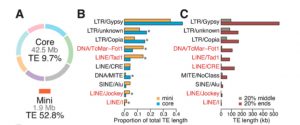 The emerging disease wheat blast is devastating and has the capacity to cause 100% yield loss. Wheat blast is caused by the fungus Magnaporthe oryzae pathotype Triticum (MoT). This pathotype is distinct from most of the pathotypes that causes disease in other plants such as M. oryzae Oryza (MoO) in rice. Very little is known about MoT, however rice blast disease has been very well studied and numerous effector genes that contribute to virulence and host specificity have been identified. Effector genes in filamentous pathogens are mostly present on rapidly evolving, transposon rich chromosome regions that are part of the ‘two speed’ genome, along with the slowly evolving core chromosome regions. Peng et al. report the genome assembly of a recently emerged highly aggressive MoT isolate B71, performed by developing a new scaffolding technology called LIEP (Long Insert End-Pair Sequencing). The B71 genome has a mini chromosome that is highly enriched in transposons and effector genes, similar to other newly emerged virulent strains. This resembles the lineage-specific chromosomes in the Fusarium oxysporum species complex. The authors speculate that the mini chromosome provides for rapid evolution, transfer, gain and loss of effector genes, and contributes to the ability of the pathogen to overcome plant resistance. (Summary by Mugdha Sabale) PLOS Genetics 10.1371/journal.pgen.1008272.
The emerging disease wheat blast is devastating and has the capacity to cause 100% yield loss. Wheat blast is caused by the fungus Magnaporthe oryzae pathotype Triticum (MoT). This pathotype is distinct from most of the pathotypes that causes disease in other plants such as M. oryzae Oryza (MoO) in rice. Very little is known about MoT, however rice blast disease has been very well studied and numerous effector genes that contribute to virulence and host specificity have been identified. Effector genes in filamentous pathogens are mostly present on rapidly evolving, transposon rich chromosome regions that are part of the ‘two speed’ genome, along with the slowly evolving core chromosome regions. Peng et al. report the genome assembly of a recently emerged highly aggressive MoT isolate B71, performed by developing a new scaffolding technology called LIEP (Long Insert End-Pair Sequencing). The B71 genome has a mini chromosome that is highly enriched in transposons and effector genes, similar to other newly emerged virulent strains. This resembles the lineage-specific chromosomes in the Fusarium oxysporum species complex. The authors speculate that the mini chromosome provides for rapid evolution, transfer, gain and loss of effector genes, and contributes to the ability of the pathogen to overcome plant resistance. (Summary by Mugdha Sabale) PLOS Genetics 10.1371/journal.pgen.1008272.
Plant microbe co-evolution: Allicin resistance in Pseudomonas fluorescens
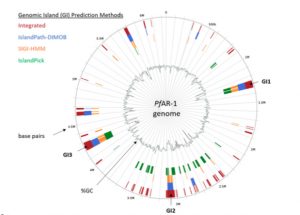 Garlic (Allium sativum L.) produces allicin (diallylthiosulfinate), which is an antibiotic defense substance. It can oxidize thiols in celular targets such as cysteines and glutathione. Because allicin has multiple sites and mechanisms of action, it is difficult for an organism to become resistant. Borlinghaus et al. isolated a highly allicin resistant Pseudomonas fluorescens strain (PfAR-1) from garlic. They used shotgun genomic cloning and whole genome sequencing to functionally identify the genes involved in conferring allicin resistance. Both approaches identified a similar set of genes grouped in three genomic islands; the genes encode mainly redox-related functions. The low GC content and absence of near related sequences to the genomic islands suggests that these regions might have arisen by horizontal gene transfer (HGT). The authors demonstrated the interdependent role of each gene within the genomic islands in creating resistance. Although the origin of these genomic islands remains unknown, related sequences were found in other Pseudomonas species including some that are known plant pathogens. (Summary by Mugdha Sabele) bioRxiv 10.1101/769265
Garlic (Allium sativum L.) produces allicin (diallylthiosulfinate), which is an antibiotic defense substance. It can oxidize thiols in celular targets such as cysteines and glutathione. Because allicin has multiple sites and mechanisms of action, it is difficult for an organism to become resistant. Borlinghaus et al. isolated a highly allicin resistant Pseudomonas fluorescens strain (PfAR-1) from garlic. They used shotgun genomic cloning and whole genome sequencing to functionally identify the genes involved in conferring allicin resistance. Both approaches identified a similar set of genes grouped in three genomic islands; the genes encode mainly redox-related functions. The low GC content and absence of near related sequences to the genomic islands suggests that these regions might have arisen by horizontal gene transfer (HGT). The authors demonstrated the interdependent role of each gene within the genomic islands in creating resistance. Although the origin of these genomic islands remains unknown, related sequences were found in other Pseudomonas species including some that are known plant pathogens. (Summary by Mugdha Sabele) bioRxiv 10.1101/769265
Exploring the hydraulic failure hypothesis of esca leaf symptom formation
 Esca is a leaf scorch (necrosis) disease of grapevine that causes tremendous yield losses. Bortolami et al. have investigated the etiology of this condition, which is known to be a consequence of fungal pathogen infection. But how exactly does the fungal infection contribute to the observed symptoms? One hypothesis is that the leaf tissues die due to vascular obstruction such as air embolisms, and another is that the cellular death arises from a fungal toxin. A big challenge to understanding this disease is that it only appears in mature vines in the field, and cannot be reproduced by inoculating young vines or in the lab. Therefore, the authors brought symptomatic vines into the lab to study them. Using X-ray micro-computed tomography (microCT), they searched for air embolisms, and they used PCR to investigate where the pathogen was present. They found that the symptoms are not a consequence of gaseous embolisms, although tylose occlusions (outgrowths on parenchyma cells of xylem vessels) are sometimes present. The pathogen appears to be largely occurring in more basal parts of the vine than where the symptoms arise. The authors propose that a toxin or elicitor may travel to the leaf tissues through the transpiration stream, and induce vascular occlusion. (Summary by Mary Williams) Plant Physiol. 10.1104/pp.19.00591 (Image from Wikimedia commons)
Esca is a leaf scorch (necrosis) disease of grapevine that causes tremendous yield losses. Bortolami et al. have investigated the etiology of this condition, which is known to be a consequence of fungal pathogen infection. But how exactly does the fungal infection contribute to the observed symptoms? One hypothesis is that the leaf tissues die due to vascular obstruction such as air embolisms, and another is that the cellular death arises from a fungal toxin. A big challenge to understanding this disease is that it only appears in mature vines in the field, and cannot be reproduced by inoculating young vines or in the lab. Therefore, the authors brought symptomatic vines into the lab to study them. Using X-ray micro-computed tomography (microCT), they searched for air embolisms, and they used PCR to investigate where the pathogen was present. They found that the symptoms are not a consequence of gaseous embolisms, although tylose occlusions (outgrowths on parenchyma cells of xylem vessels) are sometimes present. The pathogen appears to be largely occurring in more basal parts of the vine than where the symptoms arise. The authors propose that a toxin or elicitor may travel to the leaf tissues through the transpiration stream, and induce vascular occlusion. (Summary by Mary Williams) Plant Physiol. 10.1104/pp.19.00591 (Image from Wikimedia commons)
Carbon nanotube-mediated DNA delivery in intact plants
 One promising use of nanomaterials is the delivery of biomolecules into cells. Demirer et al. report a detailed protocol for Carbon Nano Tube-mediated DNA delivery into intact plants, allowing transformation without transgene integration, that can be used in both model and crop species. In brief, carboxylated Single Wall Nano Tubes (SWNT) are modified with a cationic polymer; these positively charged nanotubes are incubated with negatively charged DNA plasmid vectors, then this conjugate is infiltrated into leaves. The authors describe the delivery of plasmids encoding GFP into Nicotiana, arugula, wheat, and cotton leaves. In comparison with Agrobacterium- and biolistics-based methods, SWNT-based DNA delivery can perform a highly efficient transient transformation in a high-throughput manner, without toxicity or tissue damage. A promising use of this technique is the delivery of plasmids coding for nuclease-based genome-editing proteins. (Summary by Humberto Herrera-Ubaldo) Nature Protocols 10.1038/s41596-019-0208-9
One promising use of nanomaterials is the delivery of biomolecules into cells. Demirer et al. report a detailed protocol for Carbon Nano Tube-mediated DNA delivery into intact plants, allowing transformation without transgene integration, that can be used in both model and crop species. In brief, carboxylated Single Wall Nano Tubes (SWNT) are modified with a cationic polymer; these positively charged nanotubes are incubated with negatively charged DNA plasmid vectors, then this conjugate is infiltrated into leaves. The authors describe the delivery of plasmids encoding GFP into Nicotiana, arugula, wheat, and cotton leaves. In comparison with Agrobacterium- and biolistics-based methods, SWNT-based DNA delivery can perform a highly efficient transient transformation in a high-throughput manner, without toxicity or tissue damage. A promising use of this technique is the delivery of plasmids coding for nuclease-based genome-editing proteins. (Summary by Humberto Herrera-Ubaldo) Nature Protocols 10.1038/s41596-019-0208-9


